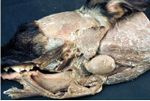Difference between revisions of "Mandibular Gland - Anatomy & Physiology"
Jump to navigation
Jump to search
| Line 29: | Line 29: | ||
*Duct opens at sublingual caruncle | *Duct opens at sublingual caruncle | ||
| − | *Innervated by facial nerve ([[ | + | *Innervated by facial nerve ([[Cranial Nerves - Anatomy & Physiology|CN VII]]) via chordi tympanii of trigeminal ([[Cranial Nerves - Anatomy & Physiology|CN V]]) |
==Histology== | ==Histology== | ||
Revision as of 15:50, 14 August 2009
|
|
Mandibular Salivary Gland
- Merocrine secretion
- Generally smaller than the parotid gland
- It is a moderately large gland in carnivores
- It is a large gland in herbivores
- Compact
- Located around angle of jaw
- Mandibular duct runs ventral to mucous membrane of floor of oral cavity, close to frenulum of tongue
- Duct opens at sublingual caruncle
Histology
- Tubulo-acinar gland
- Mucous cells (stain lighter)
- Serous demilunes (stain darker)
- Demilunes secrete into lumen by canaliculi between mucous cells
Species Differences
Carnivores
- Mainly mucous secretion in dog and cat
- Oval shape in canid
Herbivores
- Larger and deeper
